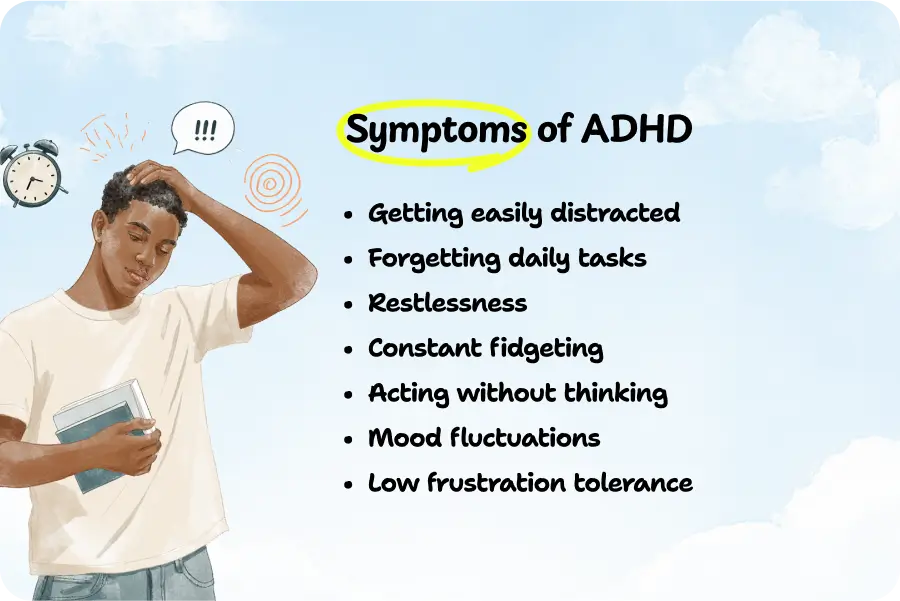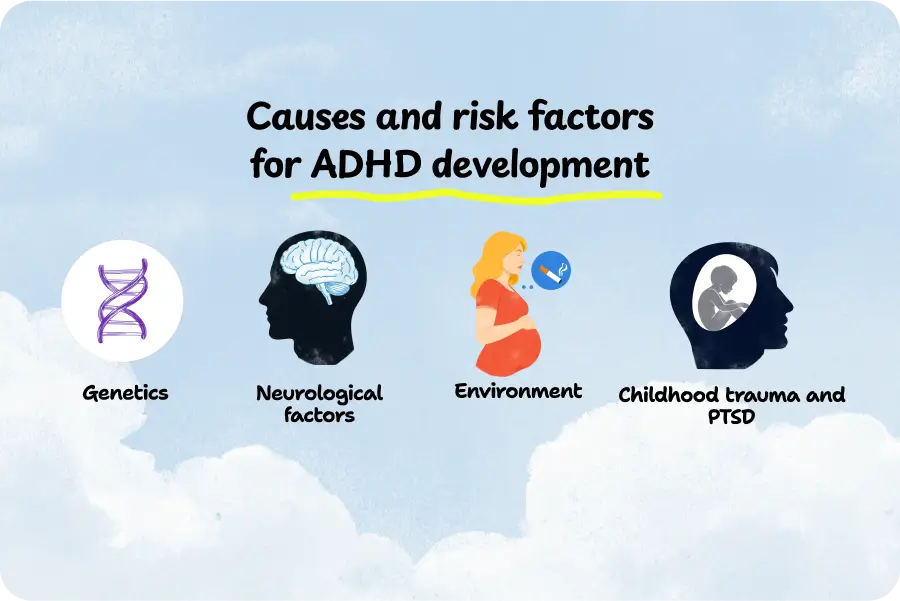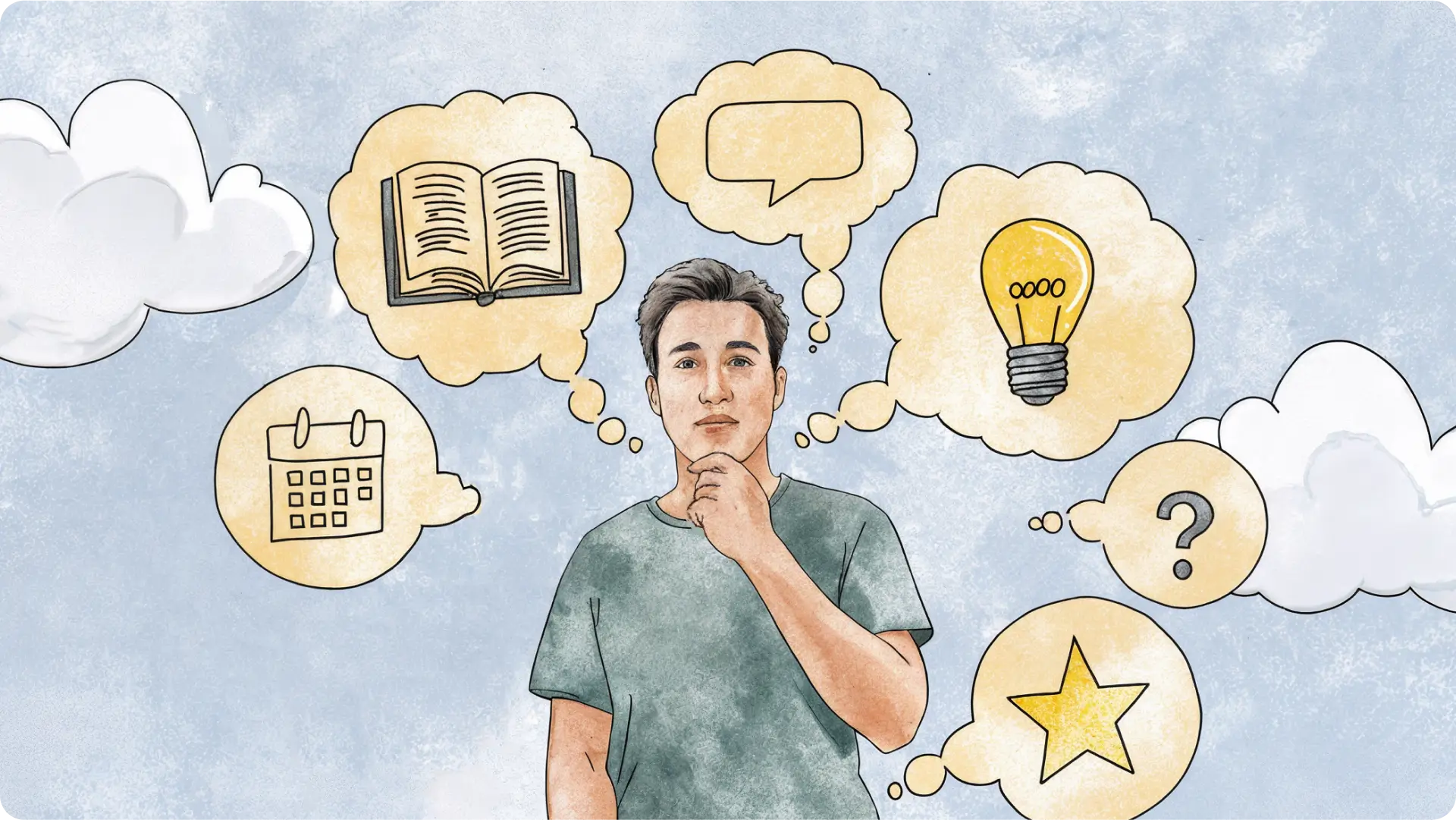There are dozens of misconceptions around ADHD diagnosis. Some believe it’s just about being hyperactive, while others state that it is a lack of discipline or focus. However, ADHD is more complex.
As more and more people open up about their disorder and more psychologists talk about it, you may start to wonder, “Do I have ADHD? I mean, I am forgetful, always late, and constantly fidgeting…”
Further, we’ll talk about the signs and symptoms of ADHD and what the disorder really means for people living with it. Keep reading to learn about what contributes to an ADHD diagnosis and how to manage its manifestations.
Understanding attention-deficit hyperactivity disorder (ADHD)
Attention-deficit/hyperactivity disorder (ADHD) is a neurodevelopmental mental health condition that causes the development of inattentiveness, hyperactivity, and impulsivity. This is a chronic disorder that might begin in childhood and persist into adulthood.
The study found that about 2.58% of adults have persistent ADHD and 6.76% have symptomatic ADHD. [1] This suggests that persistent ADHD is less common but represents a fully diagnosable condition. At the same time, symptomatic ADHD is more prevalent and may reflect milder symptoms that do not meet the full diagnostic criteria.
For instance, they might find it difficult to focus during meetings, miss deadlines, or struggle to stay organized. These challenges can lead to the increased risk of emotional distress, low self-esteem, anxiety, and depression.
At the same time, the exact cause behind ADHD symptoms is not fully known. A mix of genetic, neurological, and environmental factors can play a role in its development.
However, ADHD also has its benefits. People with it tend to be more creative and energetic. They may think outside the box and have excellent problem-solving skills. Tom Holland, Michael Phelps, Greta Gerwig, and Mel Robbins are only a few examples of celebrities who publicly acknowledged their ADHD yet managed to succeed in life and use their traits to fuel creativity. ADHD is a neurotype that represents a different brain style, which does not necessarily have to impede one’s overall life satisfaction or functioning.
ADHD types
Attention-deficit/hyperactivity disorder can manifest differently, so there are three most common types of it, as indicated in the most recent update in the DSM-5:
- Predominantly inattentive presentation means that a person has problems with focus, staying organized, and remembering important things.
- Predominantly hyperactive-impulsive presentation is more about the inability to sit still and think beforehand. Such people might be very talkative, interrupt others, and feel the need to move even in inappropriate situations.
- Combined presentation involves ADHD symptoms from both previous types.
Symptoms of ADHD
The Diagnostic and Statistical Manual 5 defines several clusters of symptoms that align with the ADHD types. To get diagnosed with the disorder, a person needs to exhibit at least six symptoms of one type for 6 months (and for the combined type, 6 inattentive and hyperactive-impulsive symptoms) and meet with a mental health professional to be formally assessed.
1. Inattentive symptoms
Such people may look distracted or absent-minded, even when they’re trying their best to focus. These symptoms tend to impact their overall daily functioning. They can:
- Miss small details or make careless mistakes.
- Have trouble focusing.
- Zone out when people are talking.
- Start doing something without finishing it.
- Struggle to keep track of time.
- Put off tasks that take a lot of effort.
- Constantly lose things.
- Get easily distracted.
- Chronically forget about plans or appointments.
2. Hyperactive symptoms
People with ADHD can live with extreme restlessness, find it challenging to calm down, and have difficulty waiting for something. They might:
- Fidget, tap, or find it challenging to sit still (engage in stimming).
- Leave their seat when they’re expected to stay seated. (e.g., at work or during classes)
- Feel restless and move around when it’s not the right time.
- Have trouble relaxing quietly.
- Always seem “on the go” or like they’re driven by a motor.
- Talk a lot, sometimes too much.
3. Impulsive symptoms
If you live with hyperactive-impulsive ADHD, you may make quick decisions and take risks more often than others. Even more, such people may:
- Blurt out answers before the question is finished.
- Find it tough to wait for their turn.
- Interrupt or butt into conversations.
- Make rash decisions
Causes and risk factors for ADHD development
Researchers have found that ADHD is highly heritable, although there is no single causal risk factor, and non-inherited factors also contribute to its etiology. [2] Below, we’ll highlight the main factors that might influence the development of ADHD. Nevertheless, if a child experiences some of them, there is a higher risk of developing the disorder, but it is not guaranteed.
Genetics
According to the study by Russell A. Barkley, Ph.D.:
- 25-35% of parents of ADHD children are adults with ADHD.
- 25-50% of siblings of children with ADHD have ADHD.
- 70-92% of identical twins of a child with ADHD have the disorder. [3]
Other studies prove that there’s no single gene that has a big effect, as each one only plays a very small role. Large studies (GWAS) show that many common gene variants together explain about a third of ADHD’s genetic risk. Rare DNA changes, like insertions or deletions, also contribute, according to the research by Stephen Vincent Faraone and Henrik Larsson.
This means that if someone in your family has ADHD, the chances are higher that you or your children might have it too. Yet, the exact outcome depends on a mix of many genes working together.
Neurological factors
Attention-deficit/hyperactivity disorder is one of the neurodevelopmental disorders, which means that it directly stems from how our mind works. ADHD is also a part of the neurodiversity umbrella, which also includes autism, learning disabilities, NVLD, and dyslexia. Particularly, the challenges with brain development can include:
- A slowly maturing prefrontal cortex makes it hard to set priorities, plan, and make decisions, according to the 2022 study by the Paris Brain Institute.
- A 2025 study published in Frontiers in Psychiatry states that if you have a smaller hippocampus and amygdala, it may be harder to control your memories, feelings, and actions.
- A smaller cerebellum can make it difficult to stop yourself from moving or doing things when it’s not the right time, according to the 2020 research published in Network Neuroscience.
- Finally, the research published in Biological Psychiatry has proven that the neurotransmitters also play a role in how brain circuits communicate. Particularly, changes in dopamine and noradrenaline signaling can affect focus, motivation, and self-control.
To put it together, ADHD develops from a mix of genetic traits, brain structure differences, and the way neurotransmitters work. These factors don’t act alone but interact with one another, which is why the disorder can look different in each person.
Childhood trauma and PTSD
The same study also states that stress and early experiences matter in the development of symptoms of ADHD. In particular, childhood trauma can impact emotional regulation, leading to difficulty paying attention and regulating impulse control. Experiences like abuse, neglect, or witnessing violence can increase the likelihood of ADHD.
Environment
The risk of the disorder increases if the mother smokes or drinks alcohol during pregnancy. Also, premature birth or a low birth weight can play a role. Exposure to toxins like lead or certain chemicals, too much screen time, or poor nutrition can affect brain development and attention as well. [4]

How to diagnose ADHD
To get an attention-deficit/hyperactivity disorder diagnosis, you need to visit a mental health professional. They will ask you about the symptoms and their manifestations and help you analyze your daily habits and specific challenges.
At what age does ADHD start?
Typically, the first symptoms begin before the age of 12. Children with ADHD might have impulsive behaviors, learning disabilities, or hyperactivity.
Please note that it’s vital not to confuse the restlessness and inattentiveness many children have in the early years (especially under the age of 5) with ADHD signs. Thus, if you suspect your kid has ADHD symptoms, it’s important to talk to a pediatrician.
Interestingly, adults can develop ADHD as well. Research published in the Industrial Psychiatry Journal states that two-thirds of ADHD patients diagnosed at age 18 did not have ADHD in their early childhood. [5] Thus, if you start thinking that you may live with certain symptoms of the disorder later in life, it can also be helpful to see a therapist.
How often do you make impulsive decisions?
How ADHD is assessed
There are no laboratory tests, like brain scans or blood tests, that let you diagnose ADHD. However, a therapist can help you identify whether you live with the disorder by conducting a clinical evaluation.
Everything starts with the interview about your symptoms and comparing them with the ones listed in the DSM-5. A therapist can also speak with your family members or closest friends to get a holistic picture.
Next, a healthcare provider can use different rating scales, tests, and reports to check whether you meet the diagnostic criteria. They may also review your medical history and any past academic challenges. By taking into account all this information, a mental health professional can come up with the ADHD diagnosis.
Can ADHD be outgrown? Does it change with age?
Attention-deficit/hyperactivity disorder can’t be outgrown. But the nature of ADHD symptoms can change over time. For some adults, it can become challenging to overcome trouble staying focused and manage difficulties with organization or executive functioning due to the loss of structure typical for childhood.
There are also studies that prove that in older women, symptoms can become more significant. [6] ADHD increases the risk of (peri)menopausal symptoms, sleep problems, anxiety, and depression.
ADHD and daily life challenges
Different ADHD presentations can bring unique challenges to a person’s life. The most common are:
1. Emotional dysregulation
People with ADHD can find it challenging to regulate their emotions and stay calm under pressure. Frustration may make them irritated or quick to anger, while even small life problems can feel overwhelming. They may find themselves reacting to big feelings more often than responding in ways they crave after the fact.
2. Poor self-esteem
Trouble paying attention can lead to problems at school or at work, which might negatively influence a person’s self-esteem. Even though both adults and younger children with ADHD can be super creative, the lack of structure can frustrate them and make them feel bad about themselves. In addition, other children at school may tease such kids, which can hurt their confidence even more.
3. Misunderstandings in relationships
If you forget about anniversaries or get distracted when someone talks about their worries, it can look like you don’t care. However, in reality, you may do your best while ADHD brings unique challenges, such as calming a racing mind or regulating thoughts and emotions long enough to be able to attend to a meaningful conversation.
To avoid arguments and misunderstandings, talk openly to your partner. Discuss your worries and find out ways to support each other. You can also set reminders or create a calendar specifically to manage things within your couple.
4. Work challenges
In a world where people need to spend 8 hours, 5 days a week, focused on their job, it can be especially challenging for people with ADHD to succeed in it. And even while there are a lot of creative jobs or opportunities to run your own business, connected tasks still require focus and organization.
Deadlines, long meetings, or the necessity to do something daily might feel overwhelming. As a result, people with ADHD might change jobs frequently or feel burned out.

Can people with ADHD live a normal life?
Yes, people with ADHD can live “normal” lives and learn to manage the symptoms of this mental disorder. Those living without a diagnosis might not even know that they have ADHD and truly believe that it’s just about their inattentiveness or natural hyperactivity.
However, it’s always better to work on managing your symptoms. If you feel that they influence your self-esteem or daily functioning, reach out to a healthcare provider or mental health clinician. Together, you’ll find ways to improve symptoms of ADHD.
ADHD in women
Attention-deficit/hyperactivity disorder in women should be approached separately, as it can bring its unique challenges. First, it’s more difficult to diagnose the disorder, as many symptoms can be mistaken for stress, anxiety, or mood-related issues.
Women tend to have the inattentive or combined type of the disorder (while men mostly live with the hyperactive-impulsive type). As a result, girls often go unnoticed in school, where their quiet daydreaming or disorganization may not raise concern due to the propensity women have to mask and blend in with their peers.
If you feel that your constant forgetfulness and inability to meet deadlines make daily life overwhelming, it may be a good idea to discuss it with a mental health professional. Maybe you live with ADHD symptoms that weren’t diagnosed in childhood.
ADHD treatment and management
The American Psychiatric Association states that adults with ADHD can benefit from medication, psychotherapy, or a combination of both. Please note that only a healthcare provider can analyze your symptoms and create a treatment plan. Here are the most possible options.
Medications
To balance brain chemicals, a doctor may prescribe stimulant or non-stimulant medications. Typically, the first option is used, but they may opt for non-stimulants if you experience intolerable side effects.
In addition, some cases of ADHD require taking antidepressants if a person experiences co-occurring depression or anxiety. This may help manage overlapping symptoms and improve overall mental state.
Behavioral interventions
Except for medications, psychotherapy plays an important role in ADHD treatment. Cognitive-behavioral therapy (CBT) and dialectical-behavioral therapy (DBT) can help you learn to manage your emotions better, develop coping strategies to avoid distraction, plan daily life, and overcome low self-esteem.
Family therapy, social skills training, and group therapy can make your life in society much simpler. During sessions, you can learn to find a common language with others and improve communication skills.
In addition, ADHD coaching may be helpful to improve executive functioning skills such as learning to set goals, plan your day, and be more productive while taking into account your unique needs.
What signs indicate that a person’s treatment plan might need to be adjusted or updated?” Katherine Scott, M.Ed/Ed.S, LMFT, answers, “Everyone’s experience with ADHD is different, and this is important for your mental health provider to take into account. It is normal for a treatment plan to be adjusted after treatment begins due to exercising tools to discover what helps and does not help, environmental factors, impacts of medication management, etc. Some signs that a treatment plan may need adjusting can include worsening symptoms, increased rates of burnout, or difficulty executing the skills or tools learned in therapy in real-world experiences outside of the therapy room. It is vital to be authentic and honest with your provider to aid in their ability to make informed decisions about your treatment plans.”
Lifestyle changes
While it isn’t a part of official treatment, many children and adults can manage symptoms much better when they have a structured and well-organized daily life. In particular, it can be helpful to:
- Maintain a healthy diet and eat consistently. Stable blood sugar levels can reduce irritability and improve concentration.
- Follow a regular sleep schedule. Quality sleep helps regulate attention, memory, and impulse control, making it easier to stay focused during the day.
- Work out regularly. Physical activity boosts dopamine and serotonin levels in the brain, which are linked to emotional balance.
To get more organized, you can:
- Plan your workload ahead
- Use checklists and calendars to follow consistent routines
- Journal your thoughts and worries to reduce emotional clutter
- Turn off notifications and limit other distractions
The Breeze app for ADHD management
You can also try Breeze, which allows you to manage the symptoms of ADHD more easily. Self-discovery tests let you find out more about the daily challenges you may face and provide tailored insights to become more productive. A mood tracker lets you notice your worries, while customizable routines are perfect for getting more organized.
ADHD and mental health
While people with ADHD can live “typical” lives, this disorder still requires a serious approach. Here’s what you need to know about ADHD and mental health challenges.
ADHD symptoms and mood disorders
Studies prove that ADHD has a high chance of comorbid depression and anxiety disorders. [7] Also, people with ADHD may have a history of conduct disorder, which involves aggressive behavior, or learning disorders, which affect reading, writing, or other cognitive skills.
The combination of ADHD and these comorbid conditions can negatively influence a person’s overall well-being and make treatment more challenging. It’s vital to address all co-occurring conditions early to tailor treatment options accordingly.
Is ADHD a mental illness or disability?
The Rehabilitation Act of 1973 and the Americans with Disabilities Act (ADA) define ADHD as a protected disability. It means that people with ADHD have the right to get support at work, school, and other places.
Can you qualify for disability with this diagnosis (ADHD)?
Yes, you can qualify for disability when living with ADHD. Yet, your symptoms should be severe enough so you’re unable to work, study, or live a normal life for more than 12 months.
Expert Insight
“Experts require a well-documented psychosocial history, including different methods of treatment you have and are exercising to move toward functionality. If ADHD is established during childhood, the diagnosis qualifies children for a 504 plan or IEP for educational accommodations. Once the child enters adulthood, the symptomology must be persistent and debilitating to one’s overall ability to function in a self-sustaining way. The process of determination in adulthood can be lengthy and draining. One can expect the Department of Disabilities to request records from other providers involved in your treatment, as well as conduct interviews with you as they create their conclusions.”
Katherine Scott
Mental health professional
Frequently asked questions
What are the top 3 signs of ADHD?
The top 3 broad signs of ADHD are inattention, hyperactivity, and impulsivity. People living with this neurodevelopmental disorder might experience one or a combination of these behavioral patterns.
What is the hardest age for ADHD?
There’s no one hardest age for ADHD because each age brings its unique challenges. However, periods of significant hormonal changes during the teenage years and menopause can make symptoms more severe.
What is the 24-hour rule for ADHD?
The 24-hour rule means that a person living with attention-deficit/hyperactivity disorder needs to spend 24 hours before making a serious decision or responding to a severe conflict. This can help you avoid impulsive behavior, analyze the situation, and make your actions more meaningful.
How do you tell if someone has ADHD without visiting a healthcare provider?
It’s impossible to diagnose ADHD without a medical evaluation. However, you can notice some patterns of behavior, particularly trouble waiting, challenges with focus, getting easily distracted, and impulsivity in daily life. It doesn’t necessarily mean that a person lives with ADHD. However, if these behaviors are persistent, they may be signs worth discussing with a healthcare professional.
Is ADHD rare?
No, ADHD may be considered quite a common disorder. Around 11.4% of US children get this diagnosis, while in some cases the disorder might still remain undiagnosed, according to the Centers for Disease Control and Prevention.
Sources
- Song P, Zha M, Yang Q, Zhang Y, Li X, Rudan I; Global Health Epidemiology Reference Group (GHERG). “The prevalence of adult attention-deficit hyperactivity disorder: A global systematic review and meta-analysis.” J Glob Health. 2021
- Thapar A, Cooper M, Jefferies R, Stergiakouli E. “What causes attention deficit hyperactivity disorder?” Arch Dis Child. 2012
- Russell A. Barkley, Ph.D. “What Causes ADHD?” 2017
- Froehlich TE, Anixt JS, Loe IM, Chirdkiatgumchai V, Kuan L, Gilman RC. “Update on environmental risk factors for attention-deficit/hyperactivity disorder.” Curr Psychiatry Rep. 2011
- Prakash J, Chatterjee K, Guha S, Srivastava K, Chauhan VS. “Adult attention-deficit Hyperactivity disorder: From clinical reality toward conceptual clarity.” Ind Psychiatry J. 2021
- Page CE, Soreth B, Metcalf CA, Johnson RL, Duffy KA, Sammel MD, et al. “Natural vs. surgical postmenopause and psychological symptoms confound the effect of menopause on executive functioning domains of cognitive experience.” Maturitas. (2023) 170:64–73. doi: 10.1016/j.maturitas.2023.01.007
- Fu X, Wu W, Wu Y, Liu X, Liang W, Wu R, Li Y. “Adult ADHD and comorbid anxiety and depressive disorders: a review of etiology and treatment.” Front Psychiatry. 2025
Disclaimer
This article is for general informative and self-discovery purposes only. It should not replace expert guidance from professionals.
Any action you take in response to the information in this article, whether directly or indirectly, is solely your responsibility and is done at your own risk. Breeze content team and its mental health experts disclaim any liability, loss, or risk, personal, professional, or otherwise, which may result from the use and/or application of any content.
Always consult your doctor or other certified health practitioner with any medical questions or concerns
Breeze articles exclusively cite trusted sources, such as academic research institutions and medical associations, including research and studies from PubMed, ResearchGate, or similar databases. Examine our subject-matter editors and editorial process to see how we verify facts and maintain the accuracy, reliability, and trustworthiness of our material.
Was this article helpful?









